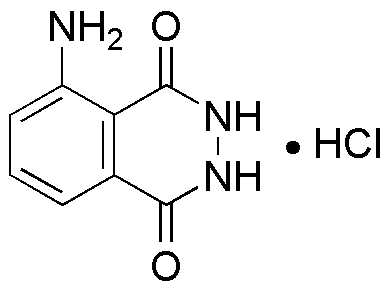Luminol hydrochloride is widely utilized in research focused on:
- Forensic Science: It is commonly used to detect trace amounts of blood at crime scenes, as it emits a blue glow when it reacts with hemoglobin, helping investigators uncover evidence that might otherwise go unnoticed.
- Bioluminescence Studies: Researchers employ luminol hydrochloride in studies of bioluminescent organisms, allowing them to explore biochemical pathways and mechanisms of light production in nature.
- Analytical Chemistry: It serves as a reagent in various assays to detect and quantify specific compounds, particularly in the analysis of reactive oxygen species, enhancing the accuracy of chemical testing.
- Environmental Monitoring: The compound is used to assess water quality by detecting pollutants and contaminants, providing critical information for environmental protection efforts.
- Medical Diagnostics: In clinical settings, luminol hydrochloride aids in the detection of certain diseases by highlighting the presence of specific biomolecules, thus improving diagnostic accuracy.
General Information
Properties
Safety and Regulations
Applications
Luminol hydrochloride is widely utilized in research focused on:
- Forensic Science: It is commonly used to detect trace amounts of blood at crime scenes, as it emits a blue glow when it reacts with hemoglobin, helping investigators uncover evidence that might otherwise go unnoticed.
- Bioluminescence Studies: Researchers employ luminol hydrochloride in studies of bioluminescent organisms, allowing them to explore biochemical pathways and mechanisms of light production in nature.
- Analytical Chemistry: It serves as a reagent in various assays to detect and quantify specific compounds, particularly in the analysis of reactive oxygen species, enhancing the accuracy of chemical testing.
- Environmental Monitoring: The compound is used to assess water quality by detecting pollutants and contaminants, providing critical information for environmental protection efforts.
- Medical Diagnostics: In clinical settings, luminol hydrochloride aids in the detection of certain diseases by highlighting the presence of specific biomolecules, thus improving diagnostic accuracy.
Documents
Safety Data Sheets (SDS)
The SDS provides comprehensive safety information on handling, storage, and disposal of the product.
Product Specification (PS)
The PS provides a comprehensive breakdown of the product’s properties, including chemical composition, physical state, purity, and storage requirements. It also details acceptable quality ranges and the product's intended applications.
Certificates of Analysis (COA)
Search for Certificates of Analysis (COA) by entering the products Lot Number. Lot and Batch Numbers can be found on a product’s label following the words ‘Lot’ or ‘Batch’.
*Catalog Number
*Lot Number
Certificates Of Origin (COO)
This COO confirms the country where the product was manufactured, and also details the materials and components used in it and whether it is derived from natural, synthetic, or other specific sources. This certificate may be required for customs, trade, and regulatory compliance.
*Catalog Number
*Lot Number
Safety Data Sheets (SDS)
The SDS provides comprehensive safety information on handling, storage, and disposal of the product.
DownloadProduct Specification (PS)
The PS provides a comprehensive breakdown of the product’s properties, including chemical composition, physical state, purity, and storage requirements. It also details acceptable quality ranges and the product's intended applications.
DownloadCertificates of Analysis (COA)
Search for Certificates of Analysis (COA) by entering the products Lot Number. Lot and Batch Numbers can be found on a product’s label following the words ‘Lot’ or ‘Batch’.
*Catalog Number
*Lot Number
Certificates Of Origin (COO)
This COO confirms the country where the product was manufactured, and also details the materials and components used in it and whether it is derived from natural, synthetic, or other specific sources. This certificate may be required for customs, trade, and regulatory compliance.


